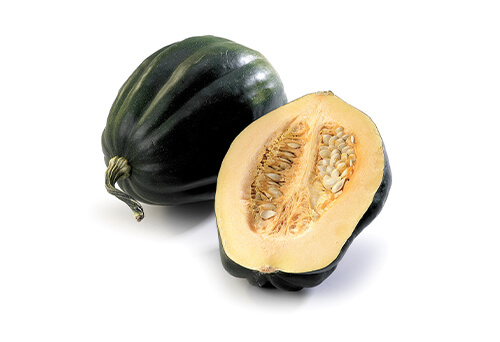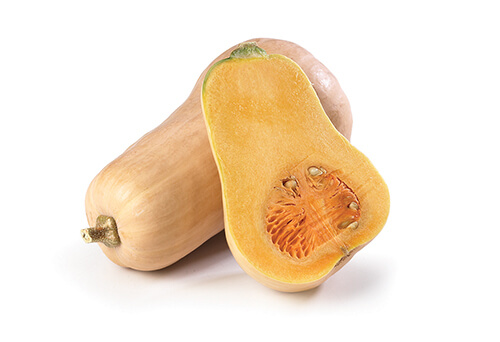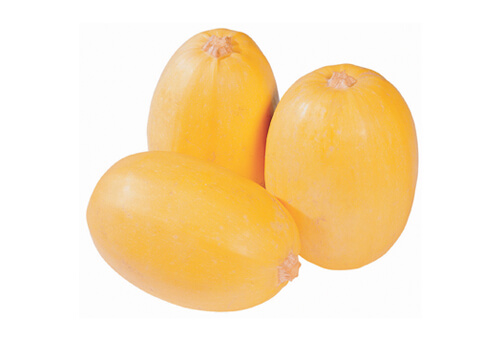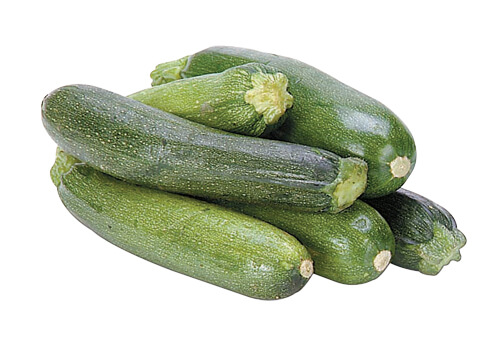Want to experiment with squash but aren't sure where to start? We've got it covered. From crisp and juicy zucchini to rich and earthy pumpkins, squash is a family of vegetables that has a uniquely wide range of flavour profiles, textures, and uses. Squash can be a key ingredient or give a flavourful boost to everything from soups to salads to drinks to loaves. We're here to break down the process of selection, prep, best uses, and storage and "squash" all your questions!
Summer squash versus winter squash
The two main varieties of squash are summer and winter, harvested twice a year, giving them very distinct flavours, shapes, and textures.
Summer squash is known for its tender edible skin and harvested before fully maturing (June through August). While full of flavour, its delicate exterior gives it a much shorter shelf life.
Winter squash, harvested in autumn, has a tough protective (typically) inedible rind to withstand fall frost (and your pantry!).
Most common types of squash

Acorn Squash
Small, round, and full of nutty, buttery flavour, this acorn-shaped winter variety has an edible dark-green rind that slowly becomes orange throughout the ripening process. Acorn squash is mild and sweet with a soft, fibrous texture.
How to choose Acorn Squash:
When buying acorn squash, look for a smooth, dry, crack-free rind that's free of soft spots and feels heavy (roughly one to two pounds). If you can nick the skin easily with your fingernail, the squash might not be fully mature.
How to prepare Acorn Squash:
Wash the exterior and slice in half from stem to end. Acorn squash isn't as tough as other winter versions and will slice easily. Scoop out the seeds (and save to roast for a snack later), then season to your liking and bake flesh side up at 190°C (375°F) for 45 to 60 minutes, or cook according to your own recipe.
Best uses: roasted, savoury dishes, sides, soups
Best paired with: honey, brown sugar, nutmeg, maple syrup, bacon, garlic, butter
Try: A sweet and savoury side: Smoky Bacon-Wrapped Acorn Squash
A main and side for the holidays: Maple-Cranberry Glazed Turkey with Spiced Acorn Squash
A cozy, hearty main: Acorn Squash with Harvest Rice Stuffing

Butternut Squash
Butternut squash is iconic for its pear shape and hard inedible skin. Commonly used as a soup base, this winter squash has a sweet nutty flesh that can also be roasted, puréed, or baked in a pie!
How to choose Butternut Squash:
Look for a dark-beige matte skin that withstands a prick from your fingernail. Ideally, you'll want minimal bruising with no green streaking, which can happen when it isn't quite ripened. Over- or under-ripened butternut squash can be dry and flavourless, so look for one that feels heavy and sounds hollow when you give it a tap with your knuckles.
How to prep Butternut Squash:
For skin-off preparation, cut off the top and bottom so both ends are flat. Next, halve the squash where the thin end meets the bulbous side. Stand each half on a flat end and peel the rind until the orange flesh is revealed. Slice the thick half down the middle and scoop out the seeds (save for roasting, of course!). Now the base is ready to cut down to your desired shape and size.
For skin-on, cut both ends, carefully halve lengthwise, scoop out seeds, season to your liking, and roast flesh side down at 204°C (400°F) for about 1 hour.
Best uses: soups, stuffed, desserts, roasted, mashed, puréed
Best paired with: cinnamon, nutmeg, rosemary, brown sugar, sausage
Try: A cream-based soup: Butternut Squash Soup
A crispy, flaky tart: Herb & Onion Butternut Squash Tart
A quick and satisfying main: Butternut Squash & Pasta Bake

Pie Pumpkin
Not to be confused with your standard carving pumpkin, the pie pumpkin (or sugar pumpkin) is its smaller, rounder, and firmer cousin. This winter squash has a notably sweet candy-like flesh that's ideal for dessert bases like pies, tarts, and, of course, lattes!
How to choose Pie Pumpkins:
Select a small, round, dense, and heavy pumpkin (roughly four to eight pounds), with a pale- to vibrant-orange rind. Skin finish ranges from shiny to dull, but look for one that has no visible bruising or soft spots and an intact dry brown stem.
How to prepare Pie Pumpkins:
Use a heavy-duty knife to puncture the top of the pumpkin. Carefully slide the knife down the centre from stem to bottom. Repeat on the opposite side and gently pull the halves apart. Now just scoop and save the seeds and you're ready to take on any pumpkin recipe!
If roasting for purée, season the halves, roast flesh side down at 204°C (400°F) for 35 to 45 minutes, then scoop out the centre with a spoon!
Best uses: desserts, beverages, soups, roasted, puréed
Best paired with: cinnamon, cloves, allspice, cream cheese, brown sugar, pecans
Try: A crisp and filling lunch: Pumpkin, Arugula & Quinoa Salad
This cosy pumpkin-spiced soup: Pumpkin Chili
A pumpkin-packed loaf: Chocolate Pumpkin Loaf

Spaghetti Squash
Summer squash has a mild, light flesh that easily takes on the flavour of additional ingredients, sauces, and spices. Spaghetti squash gets its name from its unique stringy flesh and features a pale- beige inedible rind, making it great for easy stuffing!
How to choose Spaghetti Squash:
You'll want to pick a weighty, firm, squash with its stem intact, as with other winter squash. The rind should be golden to dark yellow and pass the fingernail test. Avoid squash that has cracks, bruises, or tender spots.
How to prepare Spaghetti Squash:
After washing, use a large, sharp knife to carefully but firmly cut the squash lengthwise and remove the seeds. A popular method of preparation is noodles; to achieve that stringy noodle-like texture, season the flesh, bake cut side down at 190°C (375°F) for 45 to 60 minutes, or microwave for 12 to 15 minutes in a dish with 5 cm (2 in.) of water. Lastly, scrape out the flesh with a fork and add to your recipe! Learn more about how to cook spaghetti squash here.
Best uses: substitute for noodle dishes, stuffed with your favourite ingredients
Best paired with: Parmesan, pork, eggs, tomatoes, garlic, parsley
Try: A light and delicious main: Baked Spaghetti Squash & Meatballs
A curry-spiced side: Spaghetti Squash Curry Rosti

Zucchini
The blank canvas of the squash family, zucchini features a delicate mild-tasting flesh that easily absorbs stronger flavours. Known for its slim shape and green, yellow, or multicoloured skin, this summer squash is great cooked or raw in both savoury and sweet applications.
How to choose Zucchini:
Zucchini should be plump with no visible bruising, scratches, or dents. Ideally, it should also have some weight to it. Choose zucchini that's bright in colour and smooth-skinned with little surface texture.
How to prepare Zucchini:
Gently wash thoroughly and toss the stem. The edible skin can be peeled away or kept as you like or based on the recipe. Tip: Zucchini can also be shaved into ribbons for salad, turned into zucchini noodles, cut into slices for grilling spears as fries, chopped down for sautéing and roasting, or grated for desserts and fritters.
Best uses: noodle substitutes, carb substitutes, salads, desserts, baked, roasted, sautéed, grilled
Best when paired with: Parmesan, breadcrumbs, goat cheese, basil, salmon, chocolate
Try: Your new favourite flatbread: Zucchini Flatbreads
An almost-instant app: Zucchini & Prosciutto Roll Ups
A 30-minute main: Tomato & Cheese Stuffed Zucchini
Other types of squash
Kabocha: Also known as the Japanese pumpkin, kabochas have a deep-green rind and sweet orange flesh.
Chayote squash: This historic summer squash dates back to the 1800s and features a mild, crunchy versatile flesh.
Buttercup squash: Wintery, sweet, and creamy, it has a pumpkin-like flavour.
Squash blossoms: Like a cherry on top, squash blossoms are an edible flower that the summer and winter vines produce and it can be stuffed, fried, or used in salads.
How to store squash
Summer squash
To maintain summer squash's freshness, refrigerate immediately in a plastic bag and only wash when ready to be eaten. The summer variety lasts roughly five to seven days in the fridge, but it can also be frozen for up to 12 months (cut into pieces, blanch in boiling water for three minutes, and freeze in bags or a freezer-safe container for year-round accessibility).
Summer squash that has gone bad will turn soft and discoloured and may have an off-putting odor, so don't be afraid to toss it if it gets a little funky.
Winter squash
Winter squash is best stored in a cool, dark place, rather than the fridge, as refrigeration can distort flavour and texture. Raw uncut squash can live for up to three months in your pantry or cold room.
You'll know it's time to toss the squash when it's soft to touch or beginning to leak juice.
For long-term storage, freeze cooked squash for six to eight months to enjoy cosy winter veggies well into spring!
